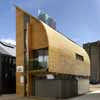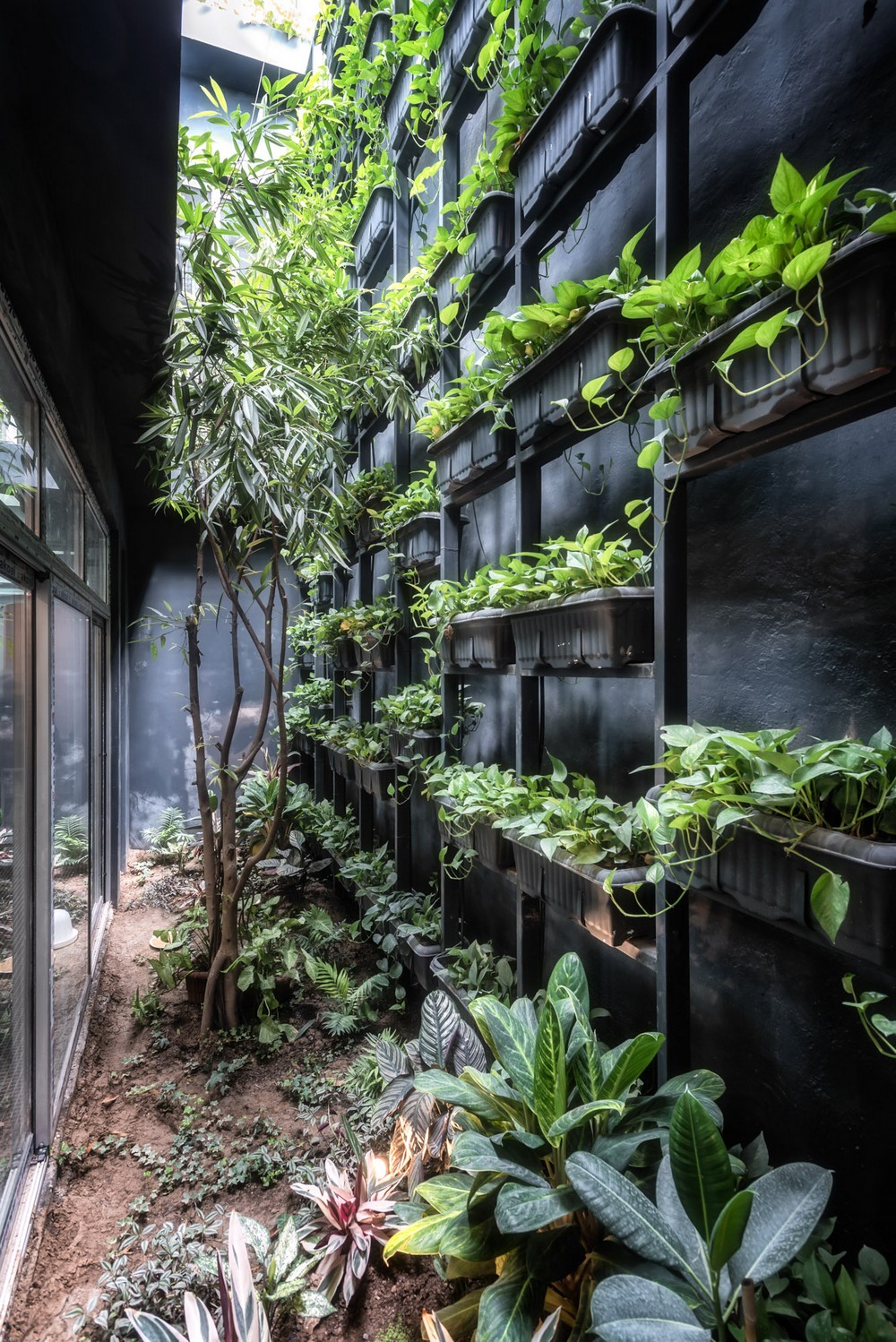Sustainable Architecture, Policy, Legislation: Opinion + Info + Links
Sustainable Architecture News
Green Building Developments – Eco Architectural Design
24 July 2019
Sustainable Architecture News 2019
Climate Emergency
Social Design Insights is a podcast that shares interviews and conversations with leading voices in social design and activism. The Curry Stone Foundation are currently focused on the climate emergency.
Curry Stone Foundation Team began this important series in late June with guest Eric Corey Freed, an American architect, author and advocate for green design and sustainability.
Episodes include:
Kian Goh, Assistant Professor of Urban Planning at the University of California Los Angeles whose research focuses on the intersections of ecological design, spatial justice and climate change. Goh’s work is known for centering racial and social justice within the climate change conversation.
Starhawk is an author, activist, permaculture designer and teacher, and a prominent voice in modern earth-based spirituality and ecofeminism. She is the author or co-author of thirteen books, including The Spiral Dance: A Rebirth of the Ancient Religion of the Great Goddess and the ecotopian novel The Fifth Sacred Thing, and its sequel City of Refuge. Her most recent non-fiction book is The Empowerment Manual: A Guide for Collaborative Groups, on group dynamics, power, conflict and communications. Starhawk founded Earth Activist Training, teaching permaculture design grounded in spirituality and with a focus on activism.
Mary Ann Lazarus is an American architect and longtime leader in the field of sustainable design. Lazarus currently works as a consultant at the Cameron MacAllister Group and has had a career of early-adoption and leadership in green building & design.
Upcoming Guests on Crisis in Climate, Crisis in Design include:
Dr. Ken Yeang is an architect, ecologist, planner and author from Malaysia, best known for his ecological architecture and eco masterplans that have a distinctive green aesthetic. He pioneered an ecology-based architecture (since 1971), working on the theory and practice of sustainable design.
Alex Steffen is an American futurist who writes and speaks about sustainability and the future of the planet. He emphasizes the importance of imagining persuasive, positive possible futures.
Bruce King is a registered structural engineer with 30 years of private consulting experience, and 25 years of leadership in the green building movement. He has served as a Green/Clean Tech advisor to numerous startups and other organizations.
New podcasts go live on Thursdays.
Curry Stone Foundation have been following the work of colleagues addressing climate emergency through organized activism. International Activist Group, EXTINCTION REBELLION, is having great success in pushing governments and organizations to recognize and address the climate crisis.
The group also released a handbook in June, 2019 through Penguin Random House “This is not A Drill”. More info here: https://rebellion.earth/2019/06/12/tomorrow-this-is-not-a-drill-an-extinction-rebellion-handbook-published-by-penguin-random-house/ Their website also does a good job sharing resources for taking action.
Curry Stone Foundation are also impressed with Greta Thunberg and encourage everyone to notice what she’s doing.
@currystonefoundation
The Foundation office is closed on Fridays for the rest of 2019.
Curry Stone Design Prize · 985 SW Disk Dr · Suite 110 · Bend, OR 97702 · USA
More Sustainable Architecture News on e-architect soon
3 Jul 2018
Sustainable Building News 2018
UK Stakeholders for Sustainable Development Report
Built environment organisations call for urgent action on issues such as consumption, innovation and infrastructure to prevent UK slipping behind other nations on poverty, equality and the environment
A new report released today (3 July 2018) has highlighted the UK’s inadequate performance against the United Nations Sustainable Development Goals (SDGs), including those for the built environment.
The report, Measuring up, from the UK Stakeholders for Sustainable Development (UKSSD), is the first comprehensive assessment of the UK’s performance against all 17 SDGs and highlights a significant danger that quality of life in the UK will worsen if action is not taken. Highlights of the report include:
• The UK is performing well (green) on only 24 per cent of its targets
• A fifth of homes in England (20%) fail to meet the Government’s Decent Homes Standard covering state of repair, basic facilities, warmth, and health and safety
• No industry, innovation and infrastructure targets have achieved a ‘good’ performance rating, with gaps in policy coverage and inadequate or deteriorating performance
• Large scale, sustained investment in replacing ageing infrastructure and creating additional resilient and low carbon infrastructure of all kinds is required
• An industrial transformation is required to make the UK economy more circular, with much higher levels of reuse, repair, recycling and energy recovery, and major improvements in resource productivity
• Access to public green space is under threat, with 59% of councils likely to lose parks and green spaces or transfer their management to others
• Despite progress, only 65 per cent of UK bathing waters are rated excellent compared to a European average of 85 per cent and almost all forms of pollution in our coastal waters is increasing
Sue Riddlestone OBE, CEO of sustainability charity and social enterprise Bioregional, which co-chairs UKSSD, and wrote Chapter 12 on sustainable consumption and production, said:
“The built environment sector has a big part to play in contributing to achieving the SDGs in the UK – after all, carbon emissions from buildings account for around a third of our emissions. It also clearly has a role to play in sustainable infrastructure (Goal 9), promoting good health and wellbeing (Goal 3), sustainable cities and communities (Goal 11) and many other goals.
“There’s a huge opportunity now for companies in the built environment – be they architects, engineers, housebuilders or developers – to take up the challenge set by the SDGs. We’re keen to work together with the industry and with the Government, and are looking to it to provide the leadership we need and provide a clear strategy to implement the SDGs in the UK.”
Judith Sykes, member of the Institution of Civil Engineers’ Sustainability Leadership Team and Director of Expedition Engineering, who co-authored the report’s chapter on SDG9: industry, innovation and infrastructure, said:
“As a wealthy, long industrialised nation, the UK should be leading the way in sustainable infrastructure but has found itself falling short. Achieving sustainability and radical reductions in greenhouse gas emissions requires existing infrastructure to be renewed or replaced. Public and private investment in new infrastructure needs to achieve large efficiency gains and contribute towards a more circular UK economy.
“Sustainable industrialisation is the backbone for achieving a range of other SDGs in the UK and across the world, linking to and impacting on targets such as those for climate change, energy, protecting habitats and biodiversity, and reducing inequalities. For this reason, ICE will build on these findings by hosting a Global Engineering Congress in October to co-ordinate a worldwide effort to tackle the SDGs where engineers can make the most impact.”
The report comes from UKSSD, the network for organisations working to advance sustainable development and the delivery of the SDGs in the UK. Measuring up is the result of a multi-stakeholder process to show the UK’s current performance against the SDGs, the opportunities and challenges ahead, and topline recommendations for achieving the SDG targets. More than 100 organisations have taken part, including businesses, charities, academia, trade unions, professional associations and government agencies.
The project looks at each of the 17 SDGs and 169 targets, and uses both existing public policy and published data to understand the UK’s performance. This wide-ranging and in-depth performance assessment has been developed as the UK Government has not yet produced a Voluntary National Review. As a result, UKSSD believes the links between targets and the need for cross sector collaboration to tackle issues are not being considered to best effect.
The report will be presented to MPs at the House of Commons today (3 July) and in New York on 17 July 2018, where the UN High Level Political Forum on Sustainable Development will take place.
UKSSD Network Director Emily Auckland said:
“We believe this report provides a solid platform for the UK Voluntary National Review to the High Level Political Forum on Sustainable Development at the United Nations in 2019. We hope it makes a valuable contribution and a starting point to the UK Government’s official approach to implementation of the SDGs. As Measuring Up shows, the consequences of not taking action are damaging for both people and places across the country.”
The full report is available from www.ukssd.co.uk/measuringup on 3 July 2018.
Background:
UK Stakeholders for Sustainable Development (UKSSD) is a cross-sector network of organisations who are working together to drive action on the UN Sustainable Development Goals in the UK. It has over 90 Partner organisations and a wider network of more than 1000 organisations.
Measuring Up was developed through a multi-stakeholder process with over 100 organisations taking part and using publicly available data and including the Office of National Statistics.
Bioregional is a sustainability charity and social enterprise that works with partners to create better places for people to live, work and do business. Bioregional co-chairs and provides the secretariat for UKSSD. Bioregional has published a guide for companies in the construction and property sector to help them tackle the SDGs. Read Build a better future with the Sustainable Development Goals.
The Institution of Civil Engineers has reached a rare milestone in 2018 – a bicentenary.
ICE 200 is a perfect chance to celebrate the institution’s longevity, recognise the profession of civil engineering and most importantly the thousands of members who make the institution what it is. ICE is using the bicentenary as an opportunity to remind the general public that civil engineers transform their lives for the better and safeguard the future for their families. In doing so, the institution also hopes to encourage young people to see civil engineering as a creative, rewarding and highly enjoyable career.
Events are planned throughout 2018 and information will be made available on the ICE website.
More information on the Global Engineering Congress can be found at www.ice.org.uk/events/global-engineering-congress
Expedition is an award-winning engineering practice with expertise in building, infrastructure and masterplanning, and specialists in civil, structural, environmental and infrastructure engineering. They deliver positive impact through applying collaborative, creative and sustainable design processes and are motivated to blaze a trail in the integrated, intelligent and ethical provision of the human environment.
More Sustainable Architecture News online soon
Sustainability Architectural Updates 2017
Eco Building Designs
6 Dec 2017
A recycling plant to be built in every new home
New technology could dramatically increase recycling rates
People should be able to recycle plastics in their own homes, and new-build houses should come with the technology ready-installed.
That’s the view of a major British waste and recycling company which says the technology already exists to allow plastics to be either pelleted or turned into useful items.
The UKs waste management agency BusinessWaste.co.uk says that while the technology isn’t suitable for every home, it’s a major step toward making the UK a 100% recycling economy.
“We’re very much at the ‘early adopters’ stage with this concept,” says BusinessWaste.co.uk spokesperson Mark Hall,” but this has the potential to grow very big indeed.
“One in every home is the dream.”
Most plastic recycling is done by big companies and involves collecting waste plastics from homes and industry to be shredded and processed.
The process has been developed to allow domestic plastic shredders, much like household kitchen waste disposals.
Householders will be left with sorted pelleted plastic waste, which they can either sell back to companies, or use for their own purposes.
Domestic uses include using plastic pellets as raw material for 3-D printers.
BusinessWaste.co.uk’s Mark Hall foresees a future where householders can just toss unwanted plastics down a chute in their kitchen, and it’s shredded and collected behind the scenes.
“While this is possibly not suitable for every household, it’s something that can easily be wheeled out firstly into executive homes, and then generally across the housebuilding industry,” he says.
But for those who want to take the entire concept to its logical conclusion, waste plastics can be shredded and converted into other plastic products in the home.
“Plastic pellets are easily converted into the ‘ink’ for 3-D printers, and from there, the sky’s the limit,” says Hall.
People already experimenting with everyday household plastic waste say they’re turning out plates, bowls, cups and other items in their own homes and garages.
“The technology’s there, it’s getting cheaper by the day, and there’s a willingness to use it. We’re heading toward a no-waste society where everybody’s involved with recycling,” the company’s Mark Hall says.
3 Dec 2017
Study on bionic drive elements could bring movement into architecture
Climate-friendly architecture thanks to natural folding mechanisms
Mobile components on buildings such as blinds whose design was copied from naturally occurring solutions — that is the subject of the research conducted by a team from the Technical University of Munich (TUM), the University of Freiburg, and the University of Stuttgart. The aim is to outfit them with drive elements that can move without any energy input. Serving as a model here are pine cones, which utilize the varying swelling behaviors of their tissue to open when moist or close when dry.
Building Climate Control Design
More Sustainable Architecture News welcome
Sustainable Architecture News Archive – up to 2013
Solar Decathlon Project, Haifa, Israel
Design: Team Israel

image from architects
Solar Decathlon Project Israel – 15 May 2013
Testing the thermal performance of various aspects of the design and the building envelope has helped fine tune the house to the desired level of performance that fits both the Israeli and Datong climates.
Almere Floriade 2022, The Netherlands
MVRDV

image © MVRDV
Almere Floriade 2022 – 6 Jul 2012
The MVRDV plan for Almere is not a temporary expo site but a lasting green Cité Idéale as a green extension of the existing city centre. The waterfront site opposite the city centre will be developed as vibrant new urban neighbourhood and giant plant library which will remain after the expo. The ambition is to create a 300% greener exhibition than currently standard, both literally green and sustainable: each program on the site will be combined with plants which will create programmatic surprises, innovation and ecology.
Gardens by the Bay Conservatories, Singapore
Wilkinson Eyre Architects

picture © Craig Sheppard
Conservatories Bay South Garden – 26 Jun 2012
Two of the largest climate-controlled conservatories in the world, the first completed part of the spectacular Gardens by the Bay project of 101 hectares.
Barratt Zero-Carbon Home
Barratt Developments unveils what they claim as the first zero-carbon house developed by a volume housebuilder. Aug 2008
Zero-carbon home, BRE site, Watford, England
Sheppard Robson with Arup

picture from architect
BRE Sustainable Schools Report
An environmentally friendly BREEAM rating can be achieved at little or no extra cost to schools, a new report claims: Sustainable Schools UK. Aug 2008
More Microgeneration Money
Scotland to triple its budget for microgeneration projects. Spending to rise to £13.5m a year, divided between community projects, householder grants & business loans (now expanded in scope to include microgeneration and well as energy efficiency).
BERR’s Low Carbon Buildings Programme householder stream
New UK-wide Lottery funding – up to £2500 for your home, but only if:
a. insulated the whole of the loft of the property to meet current building regulations e.g. 270mm of mineral wool loft insulation or suitable alternative
b. installed cavity wall insulation (if you have cavity walls)
c. fitted low energy light bulbs in all appropriate light fittings
d. installed basic controls for your heating system to include a room thermostat and a programmer or timer.
You must undertake a number of energy efficiency measures before you are eligible to apply for a Low Carbon Buildings Grant.
More information : www.lowcarbonbuildings.org.uk
Domestic Wind Turbines Axed
U-turn as proposed exclusion of wind turbines dropped (Mar 2008) from new permitted development rights for homeowners wishing to install microgeneration installations. Planning relaxations will come into force in less than a month’s time, from 6 April. The domestic relaxation will now apply only to solar photovoltaics, solar thermal water heating, heat pumps, biomass heating & CHP. Wind turbine domestic relaxation might materialise later in 2008 with a 45 decibel limit. Permitted development rights for microgeneration to commercial & agricultural businesses is also on the cards.
Size limitations will be in place, however. Solar panels attached to the building must not protrude more than 200 millimetres from the roof slope and stand alone panels must not exceed four metres above ground level or more than five metres from the boundary. Regulations were laid before parliament last week, but so far there is no sign of any planning circular on the DCLG website.
Code for Sustainable Homes
UK government announce late Feb 2008 all new homes will be required to have a Code for Sustainable Homes rating from 1 May 2008
Scottish Eco-Town
Scotland’s first ‘zero-carbon settlement’ is 5,000 home Cardenden Eco-town Fife
Zero Carbon Proposal
Welsh Assembly Government ‘aspiration’ that all new buildings should be zero carbon by 2011. Proposals incl. Severn barrage, marine power, biomass community heating schemes, community wind power and at last changing planning guidance to make installing domestic micro-generation technology easier. 28 Feb 2008
Age-friendly buildings
UK government unveil strategy for ‘age-proofing’ of all new homes, a Lifetime Homes design regime it expects to be in place by 2013 with regulation threat if it isn’t.
London Plan
Ken Livingstone announced Feb 2008 a requirement for ‘living roofs and walls’ on all major developments where feasible. An example would be DSDHA’s Paradise Park School’s ‘vertical garden’
Ken Livingstone proposals for sustainable planning policies:-
decentralised energy systems
requirement for 20% reduction in carbon emissions by new developments through use of renewable energy
requirement for living roofs & walls
Developers are to evaluate combined cooling, heat & power: the London Plan offers a hierarchy of CHP and communal heating options. Sites are to be designed to maximise future opportunities for decentralised energy.
20% renewables
The Scottish Government needs to match or exceed the European Union’s target of 20% of all energy coming from renewables by 2020 to hit its ambitious carbon-cutting objective.
Jason Ormiston, chief executive of Scottish Renewables, told Alex Salmond in Feb 2008 the key to achieving these targets is promoting the use of renewable technology to generate heat for homes. Half of all energy use in Scotland goes into heating homes. Mr Ormiston argued that to reduce carbon emissions by 80% by 2050, as proposed by the Climate Change Bill, the Scottish Government needs to support the renewable heat sector so that it is as easy to install a heat pump in a home as a flat-screen TV.
Scottish Timber
Ministerial Launch of Timber Development Programme & “New Timber Architecture in Scotland” Publication by Peter Wilson – Scottish Timber
Sullivan Report Launch
Low Carbon Building Standards Strategy for Scotland : Sullivan Report – Sullivan Report – Sustainable News
Low Carbon Performance Awards
The Chartered Institution of Building Services Engineers (CIBSE) launched the Low Carbon Performance Awards 2008 to recognise and celebrate actual, proven achievements in delivering carbon savings in buildings. It will also publicise these achievements to the building services sector, to its clients and to the wider public.
6 Feb, Grosvenor House Hotel, London. The awards are organised by CIBSE and presented as part of the CIBSE Annual Dinner – www.cibse.org
Scottish Sustainable Building Panel
Expert panel proposed to recommend ways to make Scottish buildings more energy efficient: Sustainable Architecture News Scotland
Home Information Packs
The introduction of Home Information Packs – and their included Energy Performance Certificates – will now be phased in from 1 August, rather than applied nationally from 1 June but details for Scotland awaited.
Scotland’s Executive will be introducing a mandatory information pack for property sales in Scotland, the details vary slightly from the England & Wales version and will be known as the Single Survey Scheme or Purchasers Information Pack (PIP).
Sustainable Building News 2007
Planning Guidelines SPP6 Renewable Energy
Jack McConnell declares immediate 15% reduction in carbon emissions for new buildings: new planning applications for building types over 500m2, in all Scottish local authorities, will have to demonstrate how the 15% reduction in carbon emissions will be achieved.
Consultation is proposed later this year on removing the requirement for planning re wind turbines and solar panels on existing buildings.
220307
Zero Carbon Homes
Chancellor Gordon Brown removed stamp duty from “zero carbon homes” up to the value of £500k in the Budget
The DTI’s low-carbon buildings programme launched in 2006 has been suspended due to major oversubscription
Zero Carbon Home
Stewart Milne Group have developed a prototype affordable zero carbon green home. The house will go on show in Jun 2007 at BRE in Watford. For many years there has been an ‘Eco house’ at the entry to BRE’s site.
Sustainable Housing Guide
Revised & expanded ‘Sustainable Housing Design Guide for Scotland” launched end of Jan 2007
Sustainable Housing
UK Housing minister Yvette Cooper: tour of sustainable housing in Sweden & Netherlands 2006
Yvette Cooper called for new UK homes to import their techniques + UK companies to better Scandinavian performance within 10 years
Design for Manufacture competition – Second stage: late 2006
emphasis on low carbon, eco-community developments
Sustainable new town in UK
Northstowe, Cambridgeshire, England
Code for Sustainable Homes revision
due to be issued 2006/2007
PPG3 revision
sustainable housing policies amendments, due to be issued 2006/2007
Energy Performance Certificates – EPC’s
due to be introduced as part of Home Information Packs from 1 Jun 2007
Sustainable Architecture – Carbon Neutral Homes
Gordon Brown has made significant pledges re carbon neutral housing in the UK
Dec 2006
Zero Carbon Buildings – Wales
The Welsh Assembly has set a zero carbon target in Feb 2007 for all new buildings by 2011, using devolved Building Regulations. This is 5 years ahead of the UK government target for zero carbon homes. All new buildings funded by the devolved government must be built to the BREEAM ‘Excellent’ standard within six months.
More Sustainable Architecture News welcome on e-architect
Sustainable Architecture – Scottish News
Donside Urban Village, Aberdeen
’environmentally-friendly urban village’:
Donside Urban Village – proposed hydro-electric plant; solar water heating
Scottish Carbon Extraction Power Station – halted
£500m ‘green’ power station at Peterhead put on hold by BP / Scottish and Southern Energy. Proposal extracts carbon from gas landed at St Fergus, uses it to generate electricity and pipes the carbon offshore to the Miller field. Uncerytainty re part-funding by UK government may be the reason for the delay. The project would provide ‘clean power’ for estimated 500,000 homes so cancellation would be disastrous for Scotland.
Hydrogen Office – Fife
£2.8m energy-efficient office & demonstration centre unveiled for the Energy Park in Methil 160107
More Sustainable Architecture News welcome
Sustainable Architecture : main page
Sustainable Buildings Code
All major new developments in Edinburgh will be forced to cut CO2 emissions and provide renewable energy sources on-site to comply with a new green building code. This at last brings the city into line with London, and meets the Scottish Executive’s Micro Renewables policy: new housing & other developments to generate at least 10% of their energy on site from renewable sources: Sustainable Buildings Code
Sustainable Architecture : Lighthouse ‘Sust’ Programme
Architecture Sustainability – Scotland, UK
“Sustainability” was the hot topic of the day as dignitaries and invited guests from The Lighthouse, Scottish Executive, Loch Lomond and The Trossachs National Park, and Loch Lomond Shores jointly launched Re:Motion: New Movements in Scottish Architecture, at Loch Lomond Shores on the banks of the world-famous loch. This visionary Sustainable Architecture exhibition, commissioned by The Lighthouse from eight leading Scottish architects and architectural firms, will now begin a Scottish tour following its recent successful unveiling at the International Architectural Biennale in Rotterdam. Re:Motion will be open to the public at Loch Lomond Shores Retail Crescent, Balloch.
Eight futuristic, 6-ft high plywood-framed, tent-like pods make up the exhibition, each with strong graphic images stretched over their wooden frames containing a striking mix of interactive media, projected images, models and text. Re:Motion will play a key role in The Lighthouse’s ongoing Sustainable Architecture project, “Sust.”, which explores the themes of mobility and transport and offers inspired solutions for providing more efficient transport systems in the future which minimise consumption of natural resources.
Dr Stuart MacDonald, Director of The Lighthouse, said:
“We are delighted to launch Re:Motion to the people of Scotland, and to share with them the innovative thinking of some of our top designers. The eight architectural practices taking part were given a brief to come up with alternative transport and mobility systems for the future, always keeping sustainability of natural resources to the fore. They have responded magnificently, delivering workable solutions and concepts which challenge our current thinking while also preserving precious natural resources.
“As Scotland’s national centre for Architecture, Design and the City, The Lighthouse, is the natural choice to deliver this forward-thinking project on behalf of the Scottish Executive. “Sust” will continue to promote best practice and nurture innovation to shape practical solutions which will make a difference to our future built environment.”
Gillie Thomson, Convenor of Loch Lomond and The Trossachs National Park, added:
“I am very pleased that the National Park Authority has been able to support Re:Motion’s first showing in Scotland. I am especially pleased to see that it explores new ways of looking at development since sustainability is at the heart of the National Park’s aims.
“The Park Authority itself is committed to sustainable design in developing its own buildings, one excellent example being the Gateway Centre by Bennetts Associates here at Loch Lomond Shores, recently awarded a Civic Trust Award for outstanding building design*. Another is at the Ben Lomond Memorial Park at Rowardennan which used traditional building methods in its construction. We are also at the planning stages of our permanent headquarters which will be built with good contemporary and sustainable design in mind.”
Kevin Johnson, Chief Executive of Loch Lomond Shores, commented:
“I am delighted that Re:Motion will have its Scottish debut at Loch Lomond Shores. As well as providing a stunning setting, the location is an ideal example of the joining of sustainable design and architecture and what great results can be achieved, especially in an area of such natural beauty and environmental sensitivity. Almost a million people to-date have enjoyed the unique view of Loch Lomond that has been created as a result of this project.
“The award-winning designs of the Drumkinnon Tower and the National Park Gateway Centre have attracted widespread praise and commendation from the world of architecture and beyond. It is fitting that both architectural practices involved in the creation of the buildings, Page and Park and Bennetts Associates, are also involved in the creation of Re:Motion.”
THE ARCHITECTS BRIEF
Bennetts Associates: examine the environmental cost of transport systems especially regarding co2 emissions.
Dualchas: examine reinstating ancient transport and communications routes in the Isle of Skye – a necessary consideration for the sustainability of rural communities.
Gareth Hoskins: propose eliminating congestion by relocating suburban dwellings to a new ‘Rivercity’ located in the River Clyde, a ‘bluefield site’.
Gross Max: re-examine Cumbernauld – a widely considered architectural and planning failure, although iconic of its time as the first new town to be designed for the car. New approaches could regenerate this ‘shrine to the car’.
McKeown Alexander: consider mobility within the home based on changing working and living patterns. They also explore the importance of a view of the landscape.
NORD Architects: to consider the upkeep of rural transport & communications links. The alternative is to see the demise of rural communities like St Kilda. A key element of this exhibit is the St Kilda ‘Mailboat’.
Page & Park and Miles Glendinning: examine the evolution of the city of Glasgow with changing emphasis on importance on transport systems in shaping our cities.
Sutherland Hussey Architects: propose futuristic – but realistic – forms of transport that are more sustainable and that require less infrastructure than traditional means of travel, eg airships and seaplanes. Using the city of Edinburgh as an example of the ‘future’.
Sustainable Architecture Campaign by Lighthouse – Sust PR
17 Jul 2003
More Sustainable Architecture News welcome
International Architectural Designs
Lotte Glob House – Sustainable Architecture in Scotland
Sustainable Timber Architecture
Example of sustainable architecture:
Soneva Kiri Resort, Koh Kood, Gulf of Thailand
Design: 24H > architecture

photo from architects
Six Senses’ Soneva Kiri Resort
Buildings / photos for the Sustainable Architecture News page welcome

